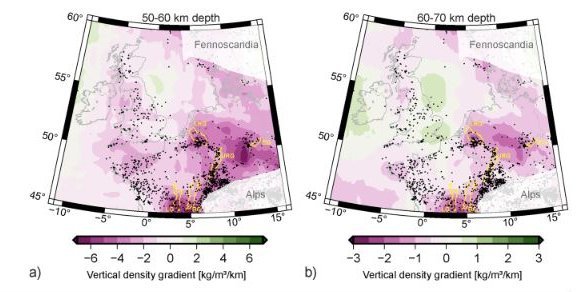Away from plate boundaries, the lateral distribution of seismic activity in the continental crust is often described as diffuse and the origin of the seismicity-driving forces unclear. For low-strain intraplate Central Europe, post-glacial rebound and pre-existing mechanical discontinuities in the crust appear to play an important role in the localization of earthquakes. However, glacial isostatic adjustments have little effects on regions farther away from Fennoscandia and the Alpine orogen and major fault zones show seismically active domains alternating with zones of seismic quiescence, leaving us with the unsolved problem of what controls the first-order pattern of seismicity. We propose that an important component of differential loading of the crust in this region originates in the lithospheric mantle. Mantle seismic tomographic models reveal that the deepest parts of the Central European lithospheric plate are characterized by large lateral variations in shear-wave velocity. Furthermore, local mantle velocity anomalies of different sizes and depth extents spatially correlate with clusters of seismicity in the crust above. These observations have motivated us to convert shear wave velocity to temperature and density and thus obtain new insights into the thermo-mechanical configuration of the upper mantle. As a result, the overall earthquake distribution in the region appears much less diffuse. Seismicity is mainly limited to regions that exhibit a low-density layer in the uppermost lithospheric mantle implying that mantle intrinsic buoyancy forces are an additional source of differential stress imposed on the crust (the less dense the mantle, the more buoyant it is). Secondly, earthquakes are clustered above lateral gradients in upper mantle effective viscosity implying that mantle deformation localizes along strength contrasts and also leads to differential loading of the overlying crust. Hence, temperature and density heterogeneities in the lithospheric mantle seem to be responsible for both mantle intrinsic forces and differential mechanical responses. Though it remains an open problem which mechanisms mechanically link the lithospheric mantle with the seismogenic zone, our study provides new clues concerning the differentiation of the study area into seismically quiet regions (e.g., Ireland, Paris Basin) and elongated zones of increased seismicity (e.g., mainland Britain, Rhine Graben system).
Publication:
Bott [Sippel], J., Scheck-Wenderoth, M., Kumar, A., Cacace, M., Noe, S., Faleide, J. I. (2024): Density and strength variations in the mantle lithosphere affect the distribution of intraplate earthquakes. - Communications Earth and Environment, 5, 243.
https://doi.org/10.1038/s43247-024-01417-4


